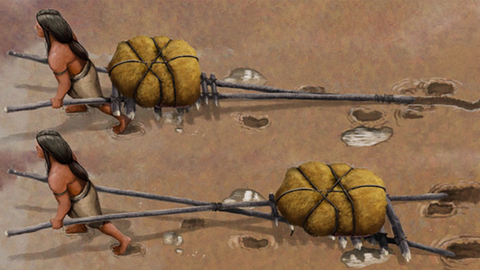Anthropology
Related: About this forum20,000-year-old evidence of ancient 'vehicles' discovered in New Mexico
By Patrick Pester published yesterday
Ancient footprints and drag marks at White Sands National Park in New Mexico suggest the earliest known Americans dragged wooden travois-like vehicles.

An illustration of two Indigenous people pulling hand cart-like contraptions
Researchers have found evidence that the earliest North Americans made makeshift "vehicles" out of wooden poles. (Image credit: Gabriel Ugueto/Bournemouth University)
The earliest known North Americans used wooden "vehicles" to transport goods, and possibly even people, more than 20,000 years ago, a new study suggests.
Researchers discovered sled-like drag marks alongside ancient footprints at White Sands National Park in New Mexico — potentially the oldest human footprint site in North America.
Indigenous people consulted in the research suggested that the marks were left by some kind of travois, a wooden frame made from two poles bound together, according to the study, which was published in the January edition of the journal Quaternary Science Advances.
Indigenous groups of the Great Plains (which includes part of New Mexico) used travois pulled by dogs (and later horses) to transport their houses, furniture and other possessions at the time of early contact with European colonizers around 500 years ago. Children and older women also rode in them at that time, according to the study. Based on the size and positioning of the ancient footprints found next to the drag marks, adults likely pulled the travois while children followed, the researchers said.
"Many people will be familiar with pushing a shopping trolley around a supermarket, moving from location to location with children hanging on," study lead author Matthew Bennett, a professor of environmental and geographical sciences at Bournemouth University in the U.K., said in a statement. "This appears to be the ancient equivalent, but without wheels."
More:
https://www.livescience.com/archaeology/20-000-year-old-evidence-of-ancient-vehicles-discovered-in-new-mexico
erronis
(21,603 posts)These were common in civilizations in Asia (elsewhere?) in earlier times.
It always amazes me when we discover that earlier generations of us had more capabilities than we were taught to believe. As if the current version of a human is so much more advanced than our ancestors.
Same for slowly understanding that other species are much more like us than we want to believe (or teach.)
NotANeocon
(465 posts)If they had wheels they would have needed to build "roads" to travel on instead of using poles which adapt to any terrain.
:: sarcasm;;